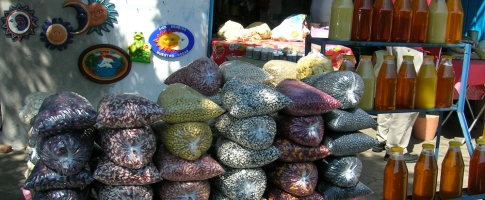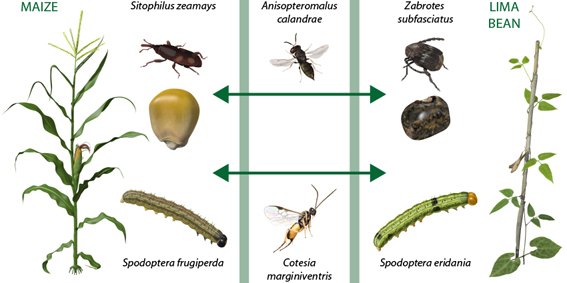Plant domestication and insect-plant interactions

Crop domestication is the process of artificially selecting plants to increase their suitability for human use. These changes have brought about an increase in yield, which often has been accompanied by a reduction in toxic compounds and an increase in nutrient content in crop plants compared to their wild relatives. In our research we use systems comprised of cultivated plants and their wild relatives as models to examine the consequences of plant domestication on the interaction between plants, the herbivores that attack them and the natural enemies of these herbivores. To do this, we use a combination of field studies, behavioural, chemical and molecular analyses. We conduct our field-work in Mexico, the centre of origin of these plants and where the greatest diversity of cultivated and wild forms is concentrated.
Apparent competition
To study whether parasitoids can mediate indirect competition between herbivores, we are currently working on two plant systems, wild lima bean and maize, which grow side by side throughout Mexico. Apparent competition is an ecological phenomenon whereby a species negatively affects another species at the same trophic level through the action of shared natural enemies. A new SNF-funded project will test the hypothesis that agricultural practices, with and without the use of pesticides, affect apparent competition between herbivorous insects in agricultural and neighbouring natural ecosystems, based on the notion that their natural enemies are particularly sensitive to pesticides. Spodoptera frugiperda, the most important foliar pest of maize, has developed resistance against pesticides. Parasitism rates seem to be low in treated fields, while larvae on nearby non-treated maize are often parasitized. Lima bean plants are attacked by Spodoptera eridania, which shares the same parasitoids, leading to reciprocal apparent competition. Moreover, in lima bean, early season herbivory can significantly reduce late season seed production and induces chemical changes that affect the performance of seed-feeding beetle larvae, as well as their parasitoids. Shortly after, different beetles attack maize cobs, and their larvae again share several parasitoids with the beetles on lima bean. This results in a new apparent competition event and brings the cascading effects to full circle as shown in the below figure depicting representative examples of the organisms involved.



